The NVIDIA GeForce GTX Titan X Review
by Ryan Smith on March 17, 2015 3:00 PM ESTMiddle Earth: Shadow of Mordor
Our next benchmark is Monolith’s popular open-world action game, Middle Earth: Shadow of Mordor. One of our current-gen console multiplatform titles, Shadow of Mordor is plenty punishing on its own, and at Ultra settings it absolutely devours VRAM, showcasing the knock-on effect of current-gen consoles have on VRAM requirements.
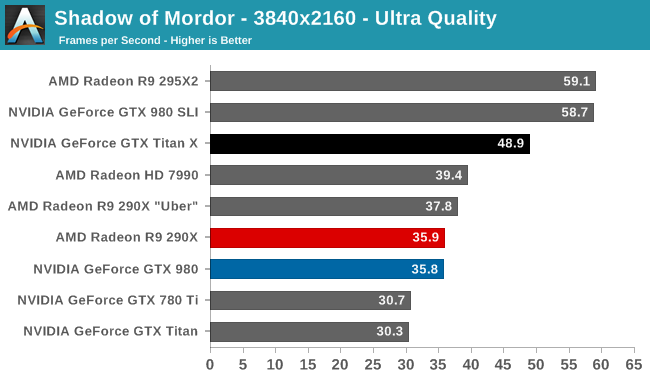
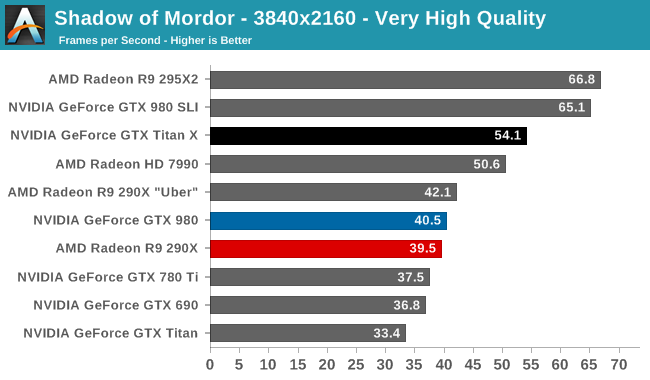
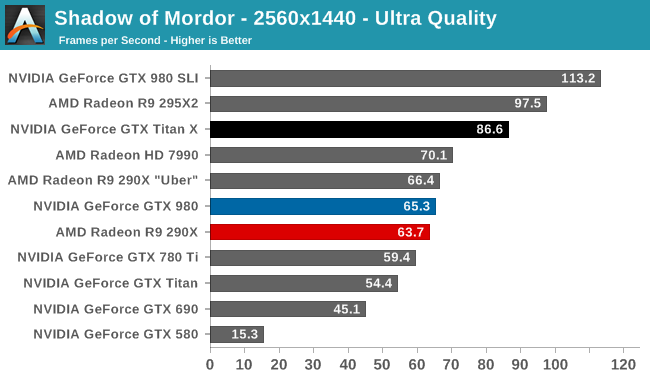
Once again even GTX Titan X won’t be enough for 60fps at 4K, but at 48.9fps it’s closer to 60fps than 30fps, representing a significant improvement in 4K performance in only a generation. Compared to the GTX 980 and NVIDIA’s other cards the GTX Titan X is once more in a comfortable lead, overtaking its smaller sibling by around 33% and the older GK110 cards at 45-60%.
Turning down the game’s quality settings to Very High does improve performance a bit, but at 54.1fps it’s still not quite enough for 60fps. The biggest advantage of Very High quality is alleviating some of the high VRAM requirements, something the GTX Titan cards don’t suffer from in the first place. Otherwise dropping to 1440p will give us a significant bump in performance, pushing framerates over 80fps once again.
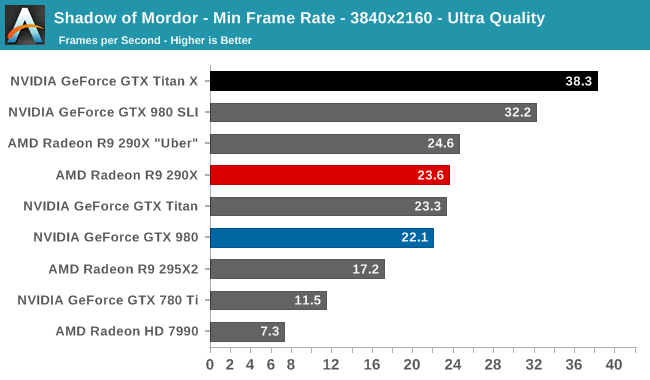

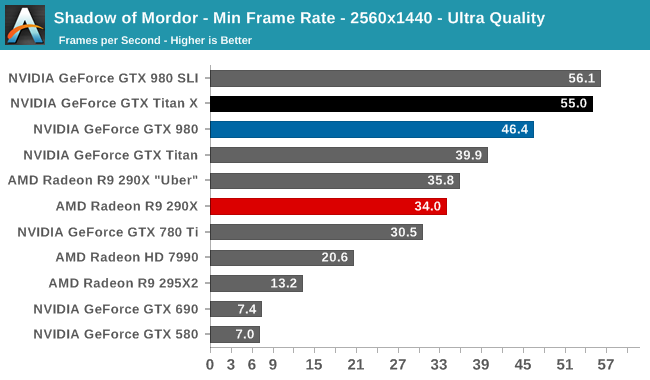
Meanwhile the game’s minimum framerate further elaborates on the performance hit from the game’s high VRAM usage at Ultra quality. 3GB cards collapse here, leaving the 4GB cards and the 6GB original Titan much higher in our charts. Multi-GPU performance also struggles here, even with 4GB cards, reminding us that while multi-GPU setups can be potent, they do introduce performance consistency issues that single-GPU cards can avoid.










276 Comments
View All Comments
modeless - Tuesday, March 17, 2015 - link
This *is* a compute card, but for an application that doesn't need FP64: deep learning. In fact, deep learning would do even better with FP16. What deep learning does need is lots of ALUs (check) and lots of RAM (double check). Deep learning people were asking for more RAM and they got it. I'm considering buying one just for training neural nets.Yojimbo - Tuesday, March 17, 2015 - link
Yes, I got that idea from the keynote address, and I think that's why they have 12GB of RAM. But how much deep-learning-specific compute demand is there? Are there lots of people who use compute just for deep learning and nothing else that demands FP64 performance? Enough that it warrants building an entire GPU (M200) just for them? Surely NVIDIA is counting mostly on gaming sales for Titan and whatever cut-down M200 card arrives later.Yojimbo - Wednesday, March 18, 2015 - link
Oh, and of course also counting on the Quadro sales in the workstation market.DAOWAce - Tuesday, March 17, 2015 - link
Nearly double the performance of a single 780 when heavily OC'd, jesus christ, I wish I had disposable income.I already got burned by buying a 780 though ($722 before it dropped $200 a month later due to the Ti's release), so I'd much rather at this point extend the lifespan of my system by picking up some cheap second hand 780 and dealing with SLI's issues again (haven't used it since my 2x 460's) while I sit and wait for the 980 Ti to get people angry again or even until the next die shrink.
At any rate, I won't get burned again buying my first ever enthusiast card, that's for damn sure.
Will Robinson - Wednesday, March 18, 2015 - link
Well Titan X looks like a really mean machine.A bit pricey but Top Dog has always been like that for NV so you can't ping it too badly on that.I'm really glad NVDA has set their "Big Maxwell" benchmark because now it's up to R390X to defeat it.
This will be flagship V flagship with the winner taking all the honors.
poohbear - Wednesday, March 18, 2015 - link
Couldn't u show us a chart of VRAM usage for Shadows of Mordor instead of minimum frames? Argus Monitor charts VRAM usage, it would've been great to see how much average and maximum VRAM Shadows of Mordor uses (of the available 12gb).Meaker10 - Wednesday, March 18, 2015 - link
They only show paged ram, not actual usage.ChristopherJack - Wednesday, March 18, 2015 - link
I'm surprised how often the ageing 7990 tops this. I had no doubt what so ever that the 295x2 was going to stomp all over this & that's what bothered me about everyone claiming the Titan X was going to be the fastest graphics card, blah, blah, blah. Yes I'm aware those are dual GPU cards in xfire, no I don't care because they're single cards & can be found for significantly lower prices if price/performance is the only concern.Pc_genjin - Wednesday, March 18, 2015 - link
So... as a person who has the absolute worst timing ever when it comes to purchasing technology, I built a brand new PC - FOR THE FIRST TIME IN NINE YEARS - just three days ago with 2 x GTX 980s. I haven't even received them yet, and I run across several reviews for this - today. Now, the question is: do I attempt to return the two 980s, saving $100 in the process? Or is it just better to keep the 980s? (Thankfully I didn't build the system yet, and consequently open them already, or I'd be livid.). Thanks for any advice, and sorry for any arguments I spark, yikes.)D. Lister - Wednesday, March 18, 2015 - link
The 2x980s would be significantly more powerful than a single Titan X, even with 1/3rd the total VRAM.